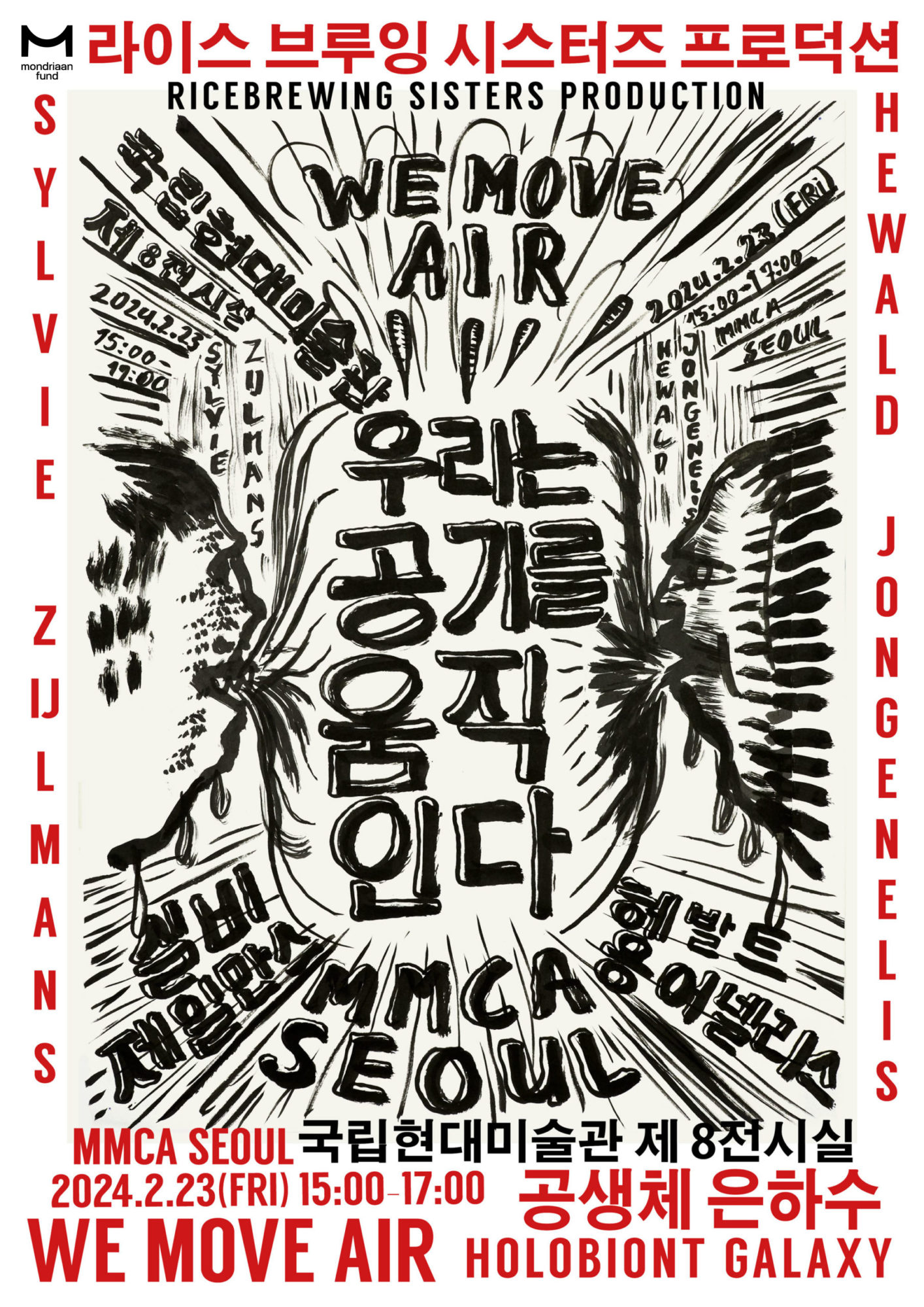
supported by the Mondriaan Fund

supported by the Mondriaan Fund
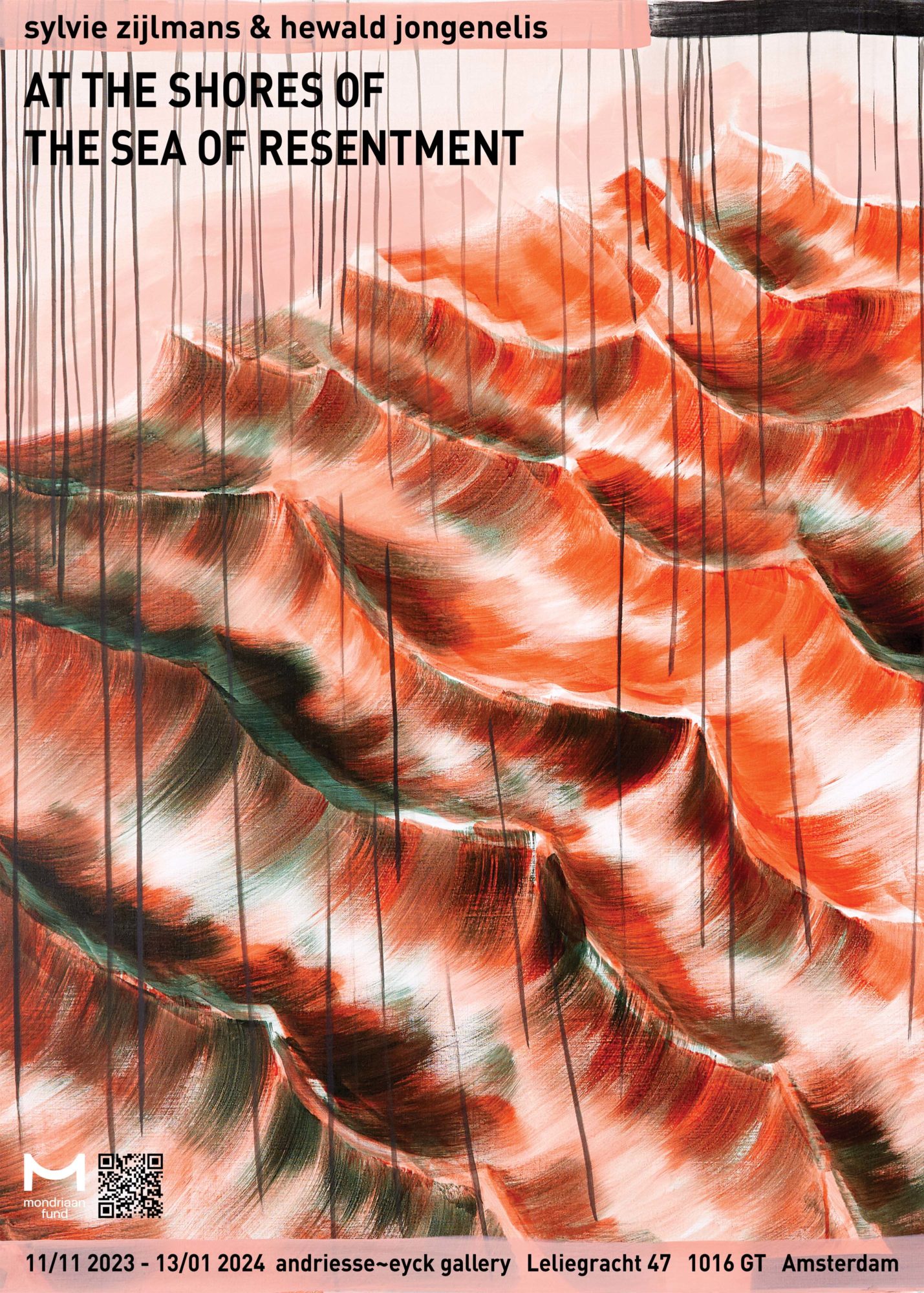
Sylvie Zijlmans & Hewald Jongenelis at the shores of the Sea of Resentment
new paintings
11/11 2023 – 13/01 2024
andriesse~eyck gallery
opening
Saturday 11/11 05:00 p.m. till 07:00 p.m.
Calling Hewald, written & conducted by Sylvie Zijlmans
performed by a 30-piece choir at opening night of “Yes I Do”
Nieuw Dakota, Amsterdam (29-09-2023)
Two new works, “Calling Hewald” and “Sylvie, I Come To Your Tyrapa Yes?” in the exhibition “Yes I Do” in Nieuw Dakota.
29/09 2023 – 27/12 2023

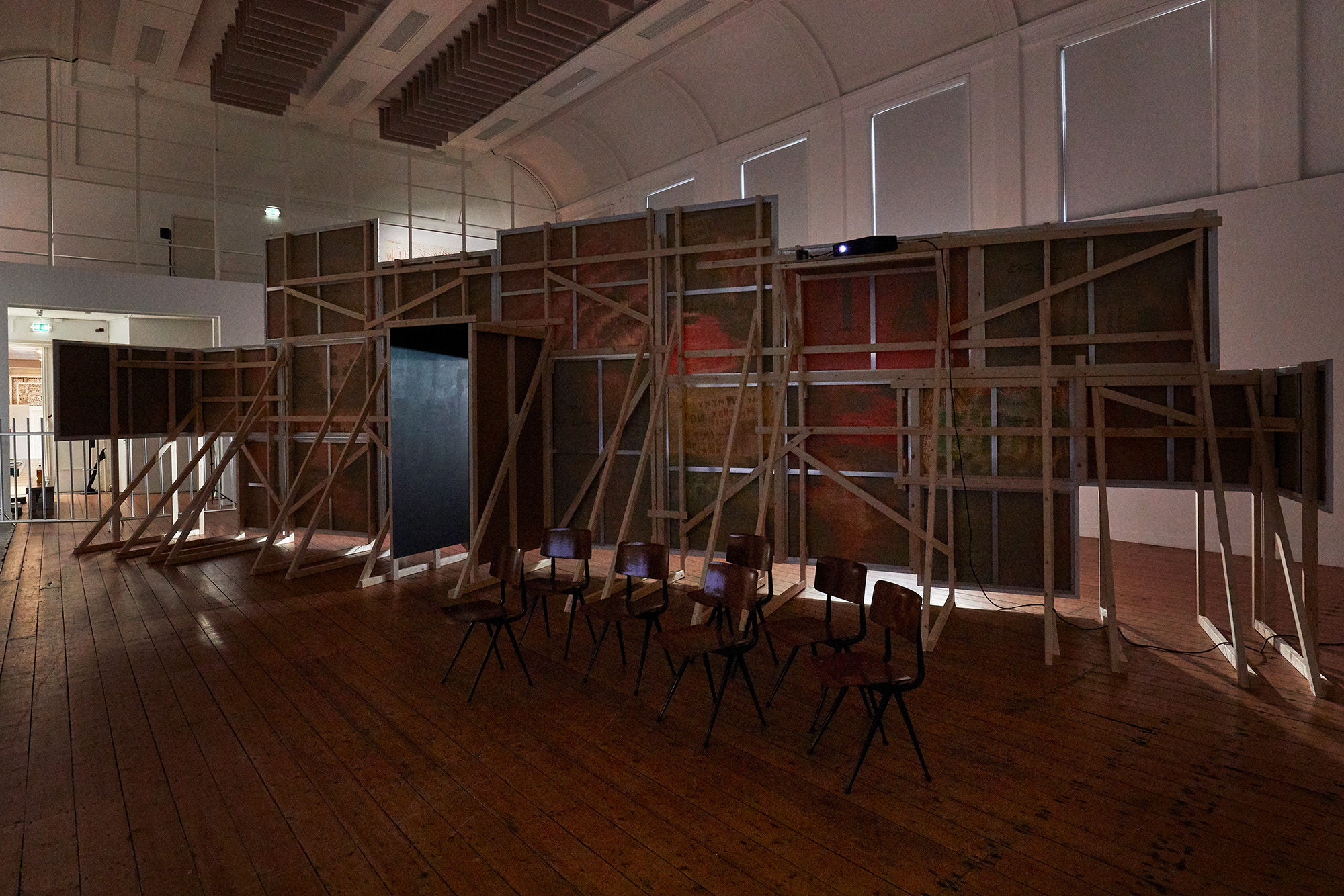
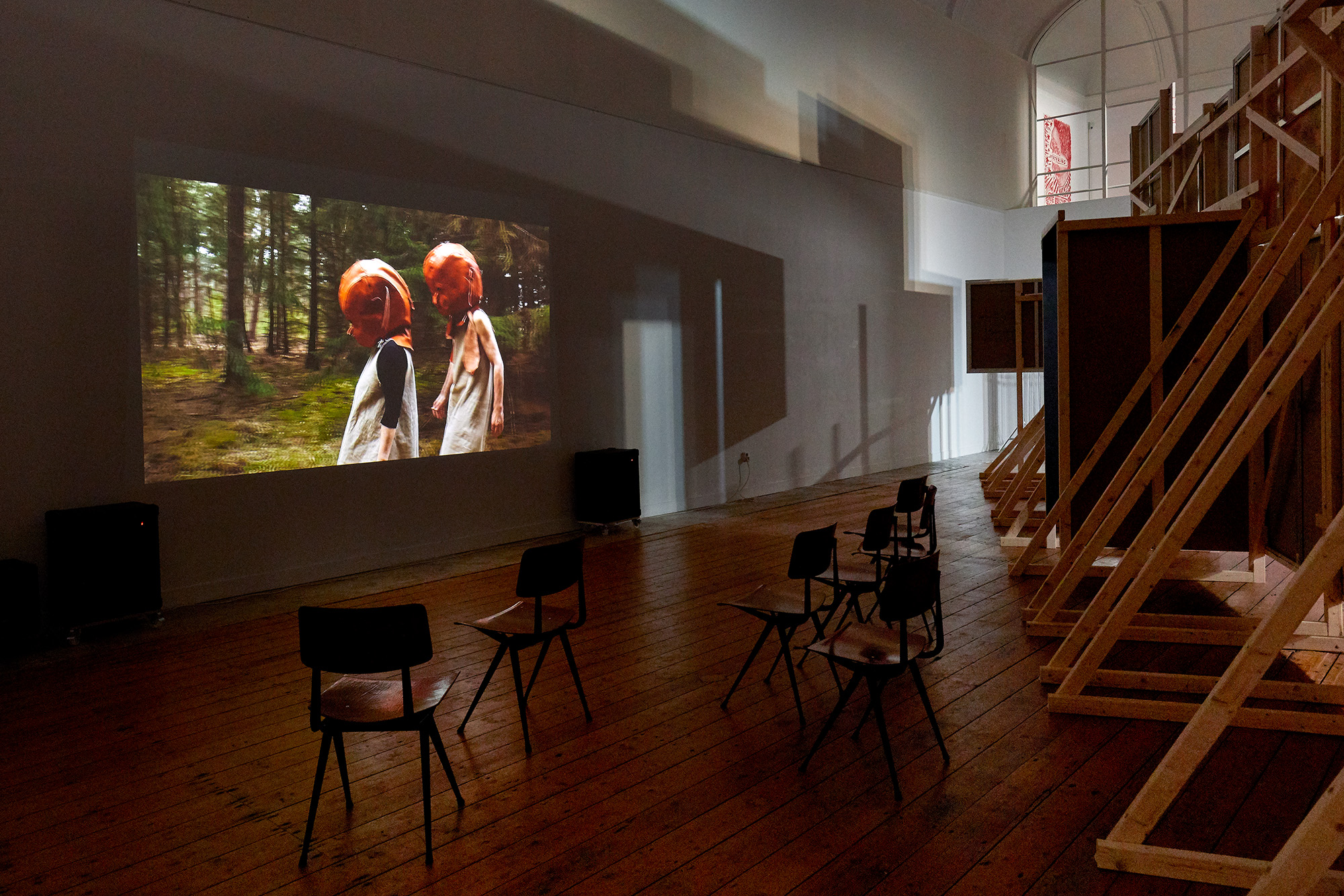


Screening in Eye Filmmuseum
The Mother Of All Failure is being screened at Eye Filmmuseum as part of the New Harvest I program of Amsterdam Art Week.
date: Saturday June 3, 16:30
more info

new paintings & video
PARK – PLATFORM FOR VISUAL ARTS
29 april – 11 juni 2023
Opening April 29 at 4 p.m. by Marlene Dumas.
At the opening there will be a special screening of the movie “They Live In Us (I Am A Very Detailed Person)” at 4:30 p.m.
PARK – PLATFORM FOR VISUAL ARTS
WILHELMINAPARK 53
5041 ED TILBURG NL
PARK013.NL
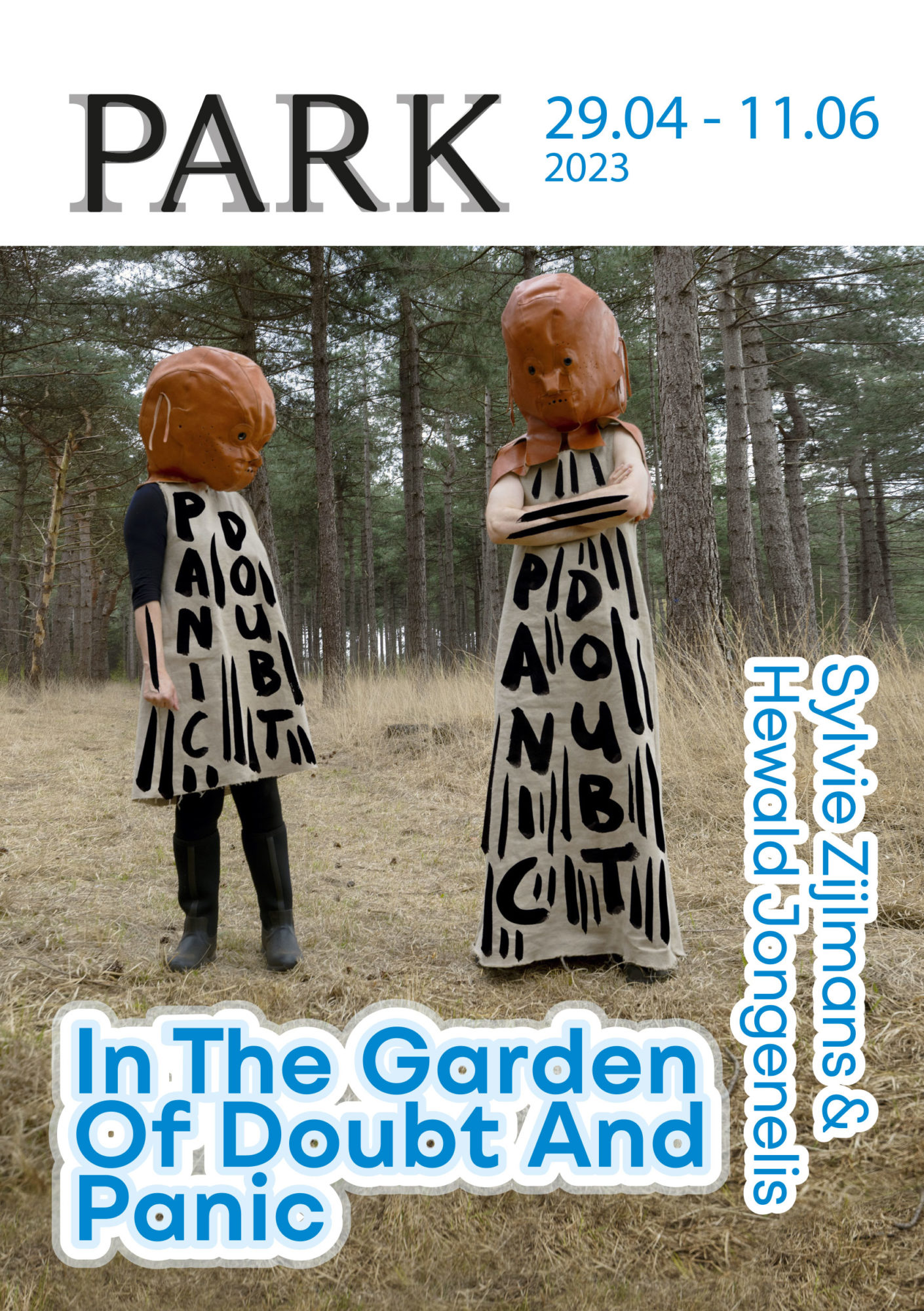
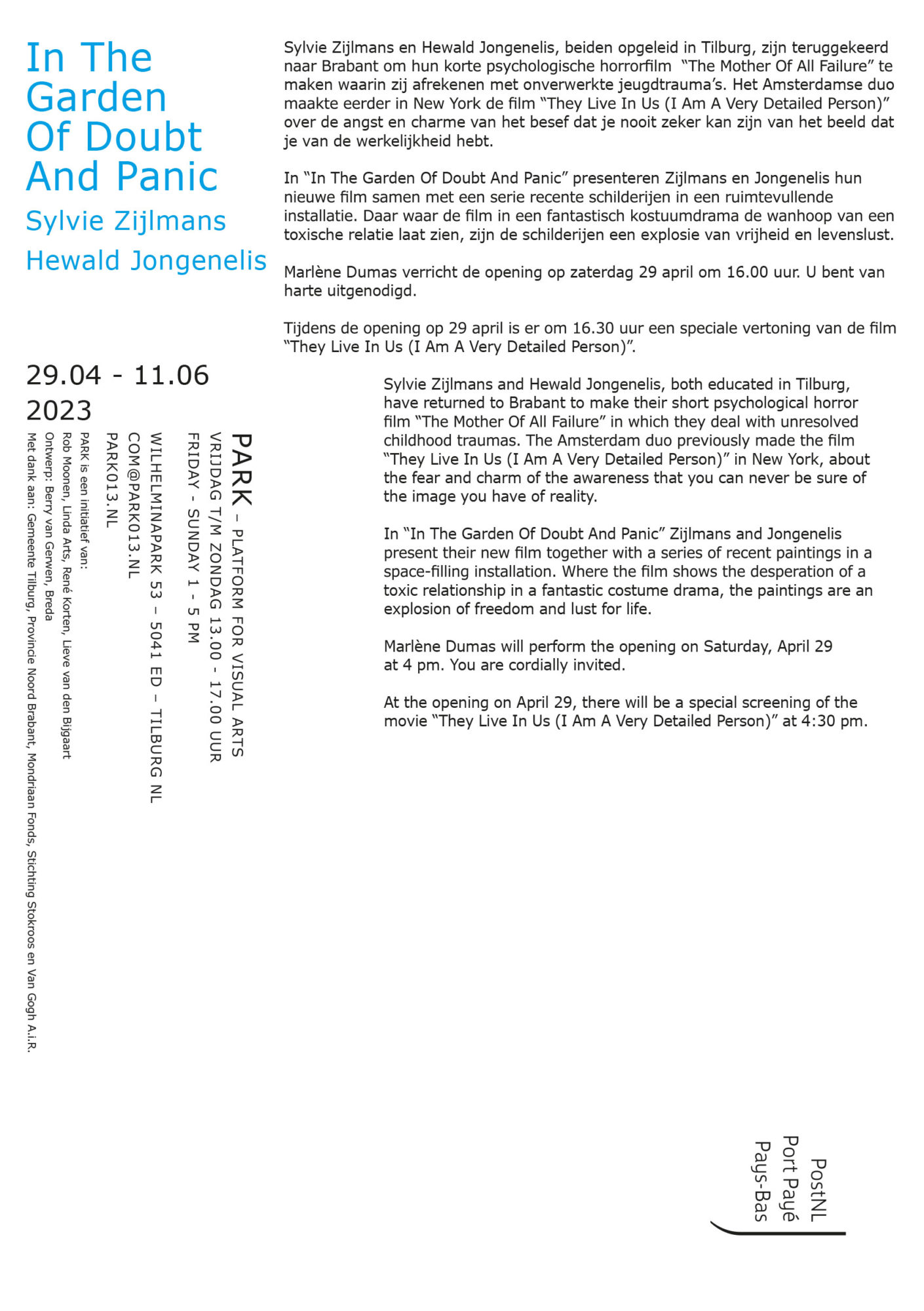
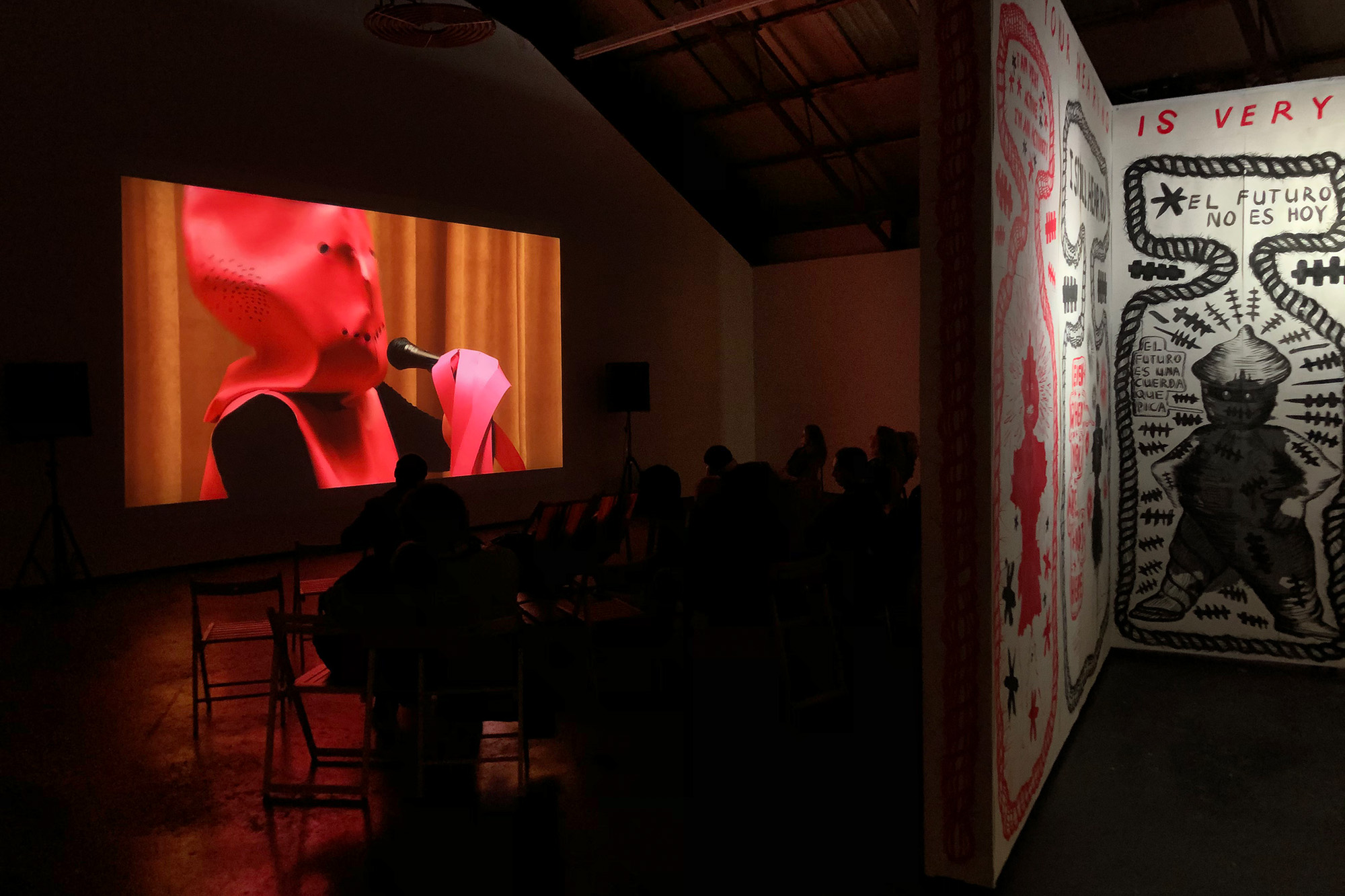
25/09/2020 – 25/10/2020 Beautiful Distress House Amsterdam
new drawings and preview screening of the short experimental film “They Live In Us (I Am A Very Detailed Person)” by Sylvie Zijlmans & Hewald Jongenelis
This project is made possible with support of The Mondrian Fund, Beautiful Distress, Amsterdam Fund for the Arts, Stokroos Foundation and Het Vijfde Seizoen.
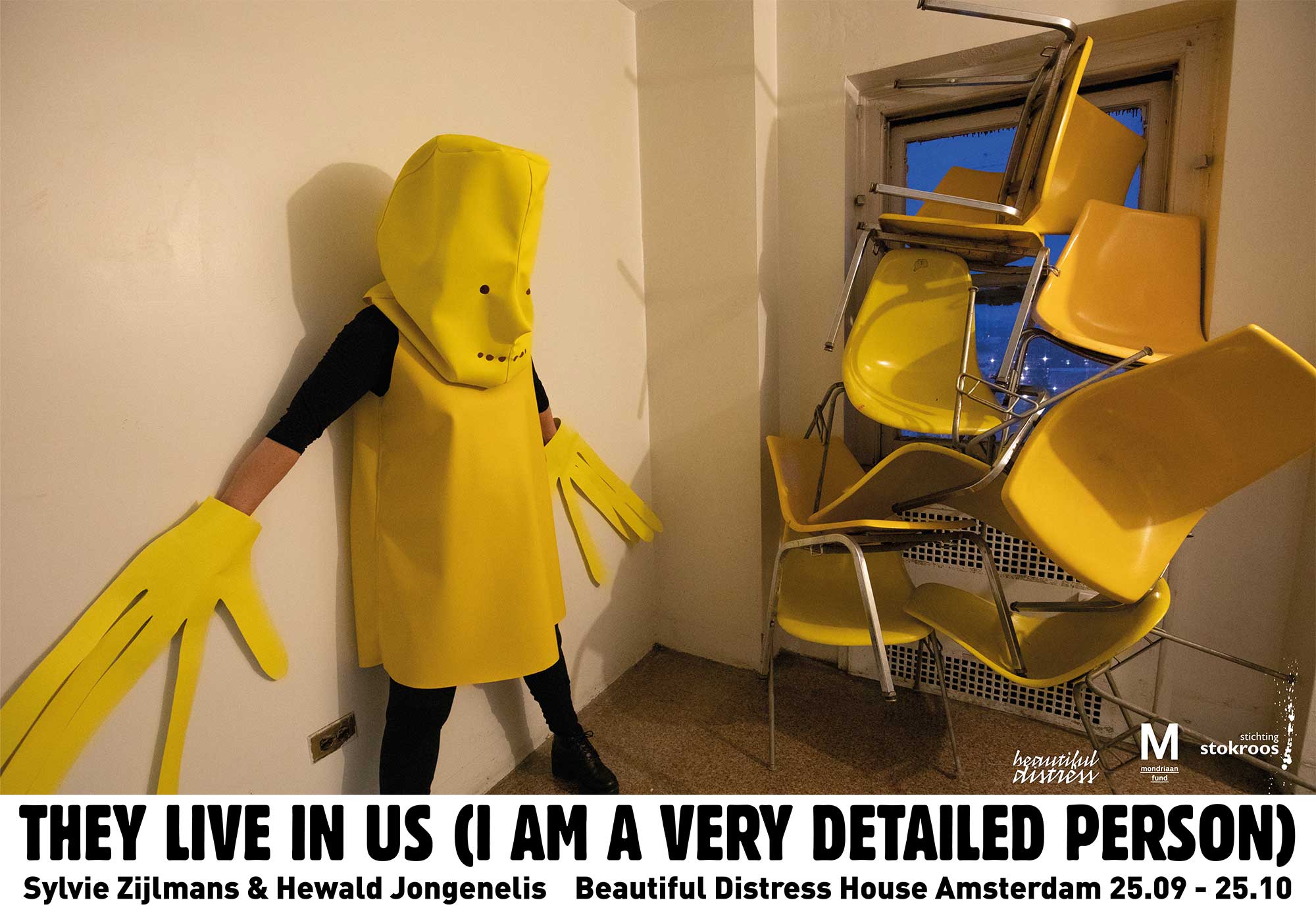



“This is not a real city” fvideostill from They Live In Us

“This is not a real city” videostill from They Live In Us

“A very detailed person” videostill from They Live In Us
Manifestations of Optimism
10 Mar — 21 Apr 2018
Opening: Saturday 10 March 5 – 7 pm
Andriesse Eyck Galerie
Leliegracht 47
1016 GT Amsterdam


The Magnetic North & The Idea of Freedom (Museum Boijmans van Beuningen Rotterdam 24/06 – 24/09/2017)
By bringing together the project ‘The Magnetic North’(2015-2016), the video work ‘The Idea of Freedom’ and their monumental red and black ink drawings, Sylvie Zijlmans and Hewald Jongenelis have created a theatrical installation about an era in which reality outdoes all fiction.
Since Zijlmans and Jongenelis moved from the busy Jordaan neighbourhood to Amsterdam-North, their new environment found its way into their work in a natural way. Their conversations with local residents highlighted several social issues. Concerns about changes to their neighbourhood, which is growing in popularity, turn out to be a recurring theme. In the course of lengthy discussions, they distilled images which position underlying personal thoughts and fears inside a larger actual, urgent and global context. These universally recognisable issues have been translated into 8 performances, filmed on location in collaboration with the local community. Each of the videos features a mythical character, an ‘avatar’, whose presence spurs the people into action. This avatar, wearing an aluminum mask, personifies pressing concerns and hidden conflicts. Given names as the Evictor, the Bouncer and the Squanderer, and with themes as gentrification, appropriation of space and the struggle to find a parking place, the project reflects on themes found in the immediate environment. At the same time it links these themes to greater themes as pollution, overpopulation, migration, the current refugee crisis and the experience of individual liberty. The red and black ink drawings, that cover all cabins and structures in the exhibition, are based on the drawings in notebooks that Zijlmans and Jongenelis kept during the talks and discussions.
With ‘The Magnetic North & The Idea of Freedom’ Zijlmans & Jongenelis turned everyday life in an expanding city into a metaphor for our time.
‘The Magnetic North & The Idea of Freedom’ was made possible with support of: het Mondriaan Fonds, AFK, Het VSB Fonds, Gemeente Amsterdam Noord, Het Prins Bernhard Cultuur Fonds, Stichting NDSM-werf, Nieuw Dakota, Museum Boijmans Van Beuningen, Coöperatie Taak, PK Waterbouw, Provincie Noord-Holland
Sacha Bronwasser in De Volkskrant
'Vrijheid versus Veiligheid' Wilma Süto in Mr. Motley
'Freedom Versus Safety' Wilma Süto in Mr. Motley (pdf)
Museum Boijmans van Beuningen
Project info, credits & archive
03’20” min video (switch on sound)
masked driver & co-driver from ‘Convoy, rally through the North’




video-still De Dichter / The Poet aka The Compactor

video-still De Dichter / The Poet aka The Compactor



video-still De Overloper / The Bouncer



De Gedoger / The Tolerator





drivers & co-drivers from ‘Convoy, rally through the North’

video-still De Verspiller / The Squanderer


Masks of The Poet a.k.a. The Compactor, The shady Illuminator, The Possessor & The Evictor impaled on the South Section of the Fence of Freedom (next to the East Gate) Museum Boijmans van Beuningen Rotterdam

Masks of The Stoker, The Squanderer, The Bouncer & The Conservator impaled on the North Section of the Fence of Freedom (next to the East Gate)


01’00” min exhibition trailer September 2017 (switch on sound)

De Conservator, die niet tegen verandering kan
The Conservator, who can’t stand change
HD video / 06:05 min / 2016
with: Sam Krijger, Minne Kersten, Bart Jan Akeboom, Boris de Klerk, Pablo Pinkus, Sjors Polm, Una Jongenelis, Igor Jongenelis & Eduard de Geer as “The Conservator”
camera: Thomas Kist, Dorothee Meddens, Sylvie Zijlmans, Hewald Jongenelis
edit & sound: Sylvie Zijlmans & Hewald Jongenelis
thanx: PK Waterbouw, Tweetakt, Mondriaan fonds




Sylvie Zijlmans & Hewald Jongenelis
Gunman (shoe for a hat, LEFT or RIGHT)
(bronze / leather platform shoe (left or right) – height 60 cm, edition: 2, 1993/2015)

Sylvie Zijlmans & Hewald Jongenelis – studio 2015

The panoramic work for the penal institution in Zaanstad was realized as a participatory project with 350 members of their staff. Under direction of Zijlmans & Jongenelis they created temporary impressions of constructive elements of a bridge, by balancing each other using ropes and bamboo sticks. Zijlmans & Jongenelis digitally assembled the bridge from photo’s of these balance situations. A total of a thousand photo’s was used to create the image that is spread out over seven panels. The panels are translucent lambda Duratrans prints mounted in LED backlit panels. The work is situated in the staff restaurant.
commissioned by: Pi2 Consortium / curated by: coöperatie TAAK (Theo Tegelaars) / coördination Pi2: Aydin Aygun / crew: Pablo Pinkus, Philippa Driest, Minne Kersten, Marianne Theunissen, Bernke Klein Zandvoort, Una Jongenelis, Jim Knip / intern: Yvonne Dubbers / prints by: Eyes on Media / frames by: Fotolight / thnx: Natascha Veeren
Penal Institution Zaanstad – 2016 / part 2 (of 7)

‘The Conservator, who can’t stand change’ @ TWEETAKT in Fort Ruigenhoek, Groenekan April 9 till May 29 2016

until October 4 2015 in Nieuw Dakota / NDSM-werf
Het Magnetische Noorden / The Magnetic North
videos & other works + live club-nights
a project by Sylvie Zijlmans & Hewald Jongenelis
in collaboration with 100 locals form Amsterdam-North
more 2015 trailers & teasers in ‘The Magnetic North’ archive
go to 'The Magnetic North' 2015 archive
original 2015 trailers & teasers
16 works for the Anna Pavilion mother-child centre of the OLVG hospital Amsterdam
(archival print on photo rag / mounted on dibond / coloured pencil)
models: children of the staff of the mother-child centre
assistance: Marianne Theunissen, Caroline Ruijgrok
thnx: Roy Taylor (studio & print)
frames: Mertens Frames Amsterdam
completion: April 2015













Sylvie Zijlmans & Hewald Jongenelis “The Sculptures [test]” 2014
Theo Schepens performs an extreme dance on the sounds of the E.L.M.O.R., the Electro-Mechanic Organ, of Sylvie Zijlmans & Hewald Jongenelis. 1998. Artis Artspace, Den Bosch the Netherlands
Dirty Pastel
Sylvie Zijlmans & Hewald Jongenelis
fashion & lifestyle project
with students of the 4th Gymnasium Amsterdam / 2013
for the full story, collection & all Dirty Models go to the Dirty Pastel website



47 seconds ‘LIVE DIRTY – LOVE PASTEL’ campaign video
& the story of Dirty Pastel, 4 minutes video, including a behind the scenes at the ‘LIVE DIRTY – LOVE PASTEL’ photoshoot. Soundtrack by Dan, Melle & Una
for the full story, collection & all Dirty Models go to the Dirty Pastel website
Sylvie Zijlmans & Hewald Jongenelis / ‘All Suits Rainbow Version’ / drawing, c-print / A4 / 2013

Sylvie Zijlmans & Hewald Jongenelis / ‘The Sculptures’/ aluminum / 2012 / collection Hans & Marijke van der Made

Sylvie Zijlmans & Hewald Jongenelis / Hans & Marijke van der Made posing in ‘The Sculptures’
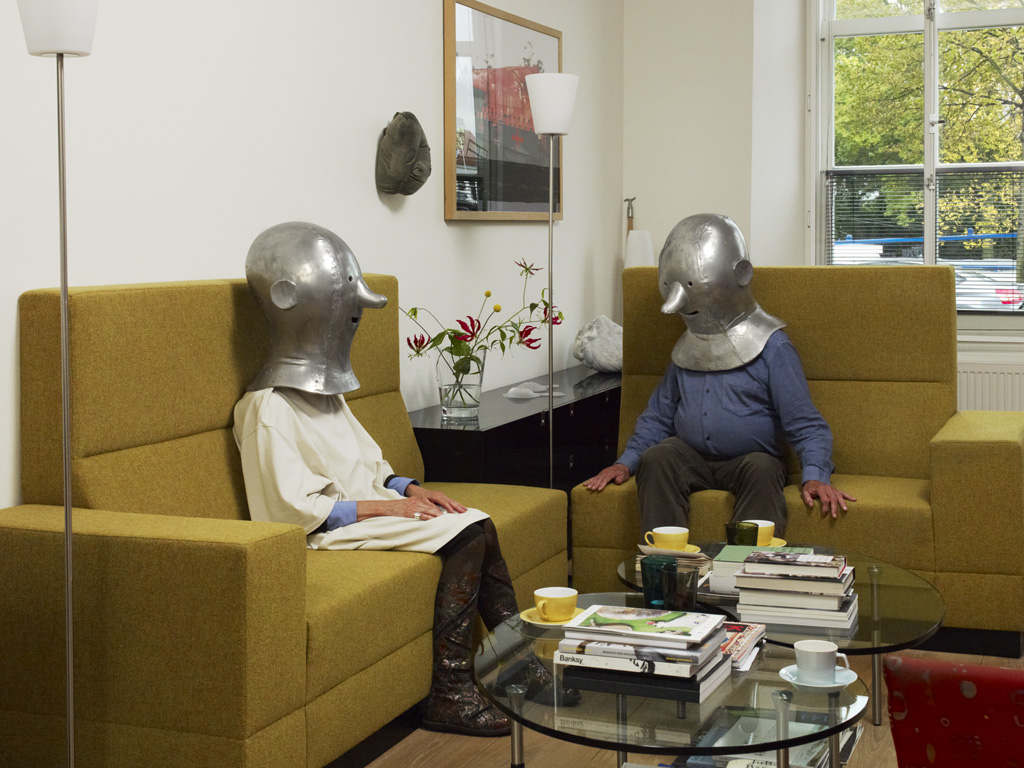
Sylvie Zijlmans & Hewald Jongenelis / ‘De Gedoger’ / ‘The Tolerator’ / 220 x 170 x 80 cm / 2012
(collection Museum Boijmans Van Beuningen)
The Tolerator commemorates a period in Dutch politics when Cabinet Rutte 1 was made possible in October 2010 by tolerating support of the populist right wing PVV (Party For Freedom) who then acted as an opposition party supporting the government’s policy.
The Tolerator is a monument for the inability to be actually involved and take responsibility for decisions. This is personified in a man who is hiding his true identity behind his back and among other things has multiple noses pinned on him, wears his fair hair as if it is blown in the wind while the back of his head is punctured with white feathers.


Sylvie Zijlmans & Hewald Jongenelis / ‘The fundamental engine of progress’ / 9 screen HD video-installation / 2012 / exhibition view ‘The Present’ Stedelijk Museum Schiedam 2012




Hewald Jongenelis / ‘The Present’ / neon/electronics / 2012
Sylvie Zijlmans & Hewald Jongenelis / ‘Dance Hall’ / installation / 2012 (The Present – Stedelijk Museum Schiedam 2012)




Sylvie Zijlmans & Hewald Jongenelis / project voor Combiwerk, Delft / 2011
Het kunstwerk vereeuwigt de medewerkers van de sociale werkplaats Combiwerk in Delft als individu en als groep en laat zien dat ze collectief tot grote daden in staat zijn. Zijlmans & Jongenelis fotografeerden iedereen individueel als touwtrekker en monteerden de meer dan 600 foto’s tot het beeld van de enorme groep die eensgezind een homp zilverkleurig materiaal ophijst.
opdracht: gemeente Delft / Combiwerk
afmetingen print: 360 x 500 cm / enamel steel print: Alliance Genk (B)
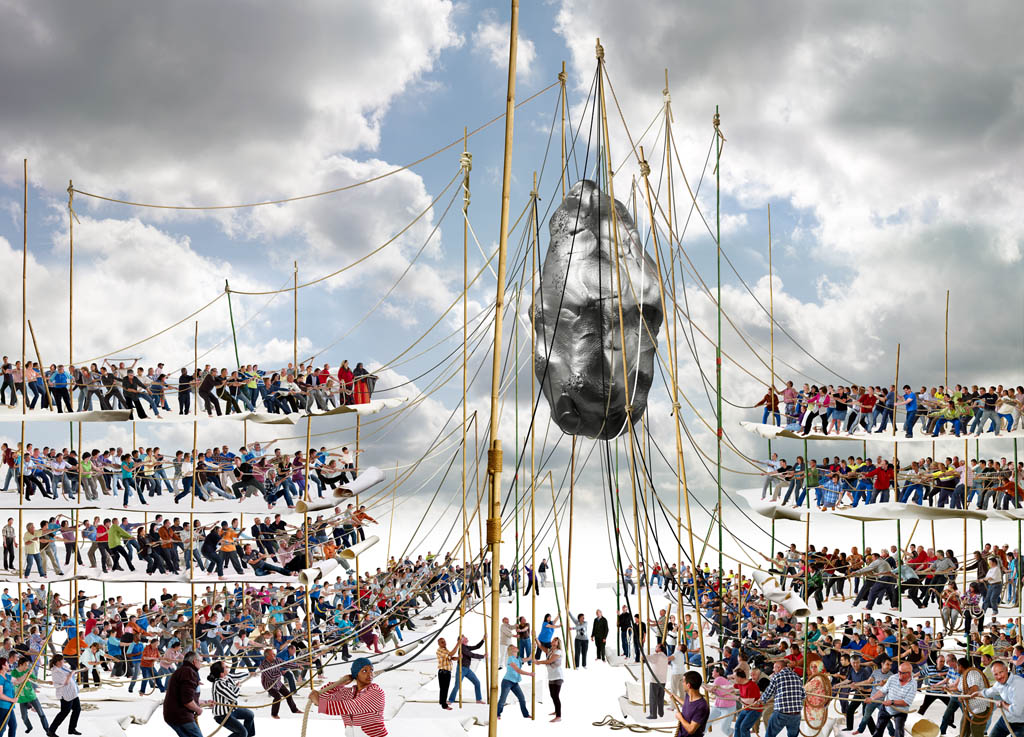


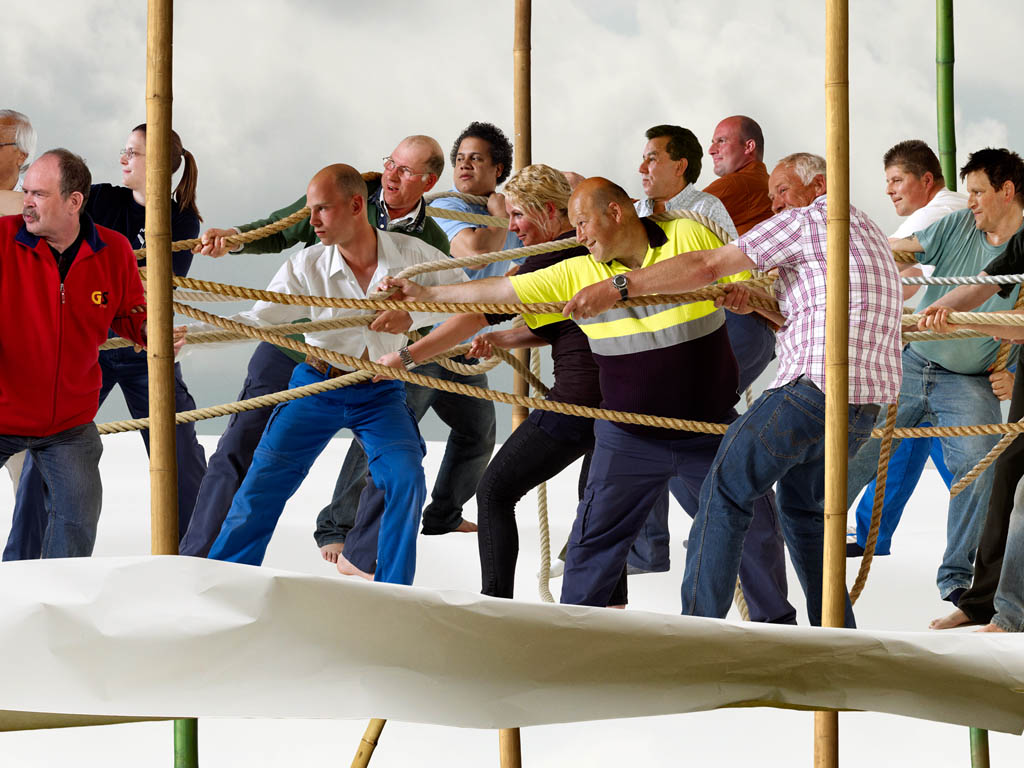



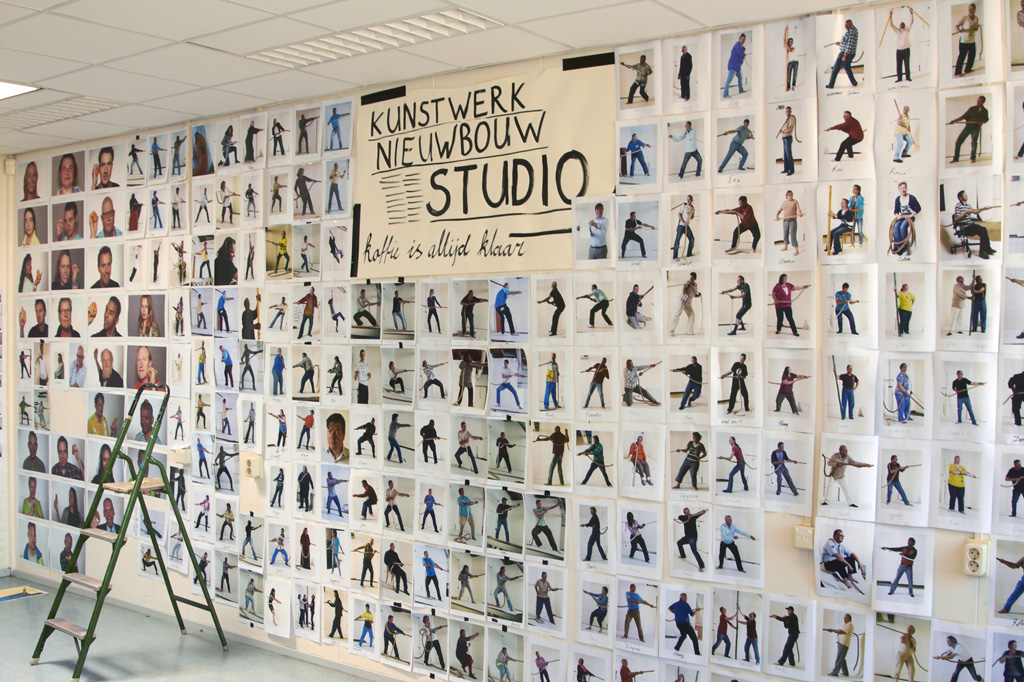


Sylvie Zijlmans & Hewald Jongenelis / project for Combiwerk Delft / Combiwerk Delft – behind the scenes / 2011
Sylvie Zijlmans & Hewald Jongenelis / ’the Olly Project’ / aluminium/canvas / 2010-
Aan het beeld ‘Olly’ kan een tent-constructie bevestigd worden. Het beeld verandert dan in een kleine 12-hoekige feesttent: ‘Olly’ plopt door de bovenkant van het tentdoek als een ‘master of ceremony’ met een wijd uitwaaierende rood-witte rok aan.
‘Olly’ is niet alleen functioneel als kleine feesttent maar je kan er ook heel goed slingers aan bevestigen. Het beeld is geïnspireerd door de manier waarop in Amsterdam-Noord, waar Zijlmans & Jongenelis hun atelier hebben, tijdens voetbaltoernooien van het Nationale elftal hele wijken oranje kleuren omdat aan alle bomen, lantaarnpalen en huizen slingers opgehangen worden. Zijlmans & Jongenelis startten in 2008 het ‘Olly project’ om een beeld te maken dat bedoeld is om op zo’n manier te gebruiken. In 2010 is het prototype ‘Olly’ gerealiseerd.
De Waker & De Slaper zijn twee witte taps toelopende betonnen torens met bovenop een bronzen luid-klok. Op elke toren staan vertikaal drie woorden, als een ultra kort, driewoordig gedicht: “WAKER – WERKER – PRATER” en “SLAPER – DROMER – ZWIJGER”. De Waker markeert het moment dat de wijk ontwaakt en veel mensen de wijk verlaten om naar hun werk te gaan: de klok van De Waker slaat rond 08:00 uur ʻs ochtends. De Slaper markeert het moment dat iedereen terugkomt: de klok van De Slaper slaat rond 18:00 uur ʻs avonds.
lokatie: Nieuwland, Amersfoort / opdrachtgever: Gemeente Amersfoort / solar powered / klokken geleverd door Koninklijke Eysbouts
Sylvie Zijlmans & Hewald Jongenelis / ‘All Suits’ / Xiamen Catwalk / 2008-2010 / 01:39 min SD video
Sylvie Zijlmans & Hewald Jongenelis / beel voor School voor Praktijk Onderwijs PP 12a, Zutphen / 2006
Op PP 12 a wordt vanuit de praktijk gewerkt, er worden veel werkstukken gemaakt. Zijlmans & Jongenelis maakten voor de binnenplaats van de nieuwbouw een beeld waarop werkstukken tentoongesteld kunnen worden: een grote man die een hand voor zich houdt en zijn andere hand achter zijn rug verbergt. Op allebei de handpalmen kunnen werkstukken getoond worden, heel goed gelukte, of juist wat minder geslaagde, hele kleine of juist enorm grote. Ze kunnen op de voorste hand, heel goed zichtbaar, of juist op de achterste hand geplaatst worden. Worden ze dan verborgen of juist ‘achter de hand gehouden’? De handen zijn sterk genoeg om bijvoorbeeld met kerst ook een flinke kerstboom te torsen, en de hoogte van het ronde witte podium waarop het beeld staat is de perfecte hoogte om op te zitten. Daarmee is het beeld voor PP 12a een beeld dat als het niet gebruikt wordt tot de verbeelding spreekt en in het gebruik functioneel is op de binnenplaats.
Sylvie Zijlmans & Hewald Jongenelis / Sociale Verzekringsbank, Utrecht / 2002-2003
meer info over dit projekt op de site van SKOR
Sylvie Zijlmans & Hewald Jongenelis / project for primary school ‘De Vuurtoren’ Scheveningen / 2003
A large trophy cabinet is topped by a man with a flashing head. His head flashes red with shame, pride or exertion or a combination of them all. Who knows? The trophy cabinet, or rather a beautiful cast aluminum trophy shelf, is visible from the street. It is illuminated at night. The installation gives everyone who passes by a glimpse of the achievements of the school’s pupils. Also part of Zijlmans & Jongenelis’ artwork for Christian primary school The Lighthouse is a series of five composite group photographs of children, selected on the basis of different physical characteristics. The same hair style, different skin colours, pose and more were deciding factors for composing the various teams.
A school’s task is to instruct pupils in a number of subjects, but it is also a place for children to meet children and children to meet adults. In that context, various patterns and ‘rules’ become apparent. Who are you in that structure? And how do you maintain your individuality? Identity and competition are important elements. Are you chosen first or last for the team in gym? And which characteristics decide that? Are you popular or not? And what does that depend on? The composite portraits illustrate this side of the school jungle. Zijlmans & Jongenelis photographed all the school’s students and teachers in a standing or kneeling position and from these shots chose the portraits for the montages. Are you in this photo, are you part of the team? And why were you selected? These are questions that immediately call the images to mind. The images are mysterious, because you have to think about what unifies the group. With the photos, Zijlmans & Jongenelis make it clear to everyone that ‘unwritten’ rules exist, but also that these are often ridiculous, relative and malleable. The trophy cabinet is symbolic of the common effort. You win the trophies together, for the honour of the school, of your class, your group. You show everyone out there that you can operate as a team, and do so successfully. And that’s worth telling the world.
Text: Femke Lutgerink (edit)









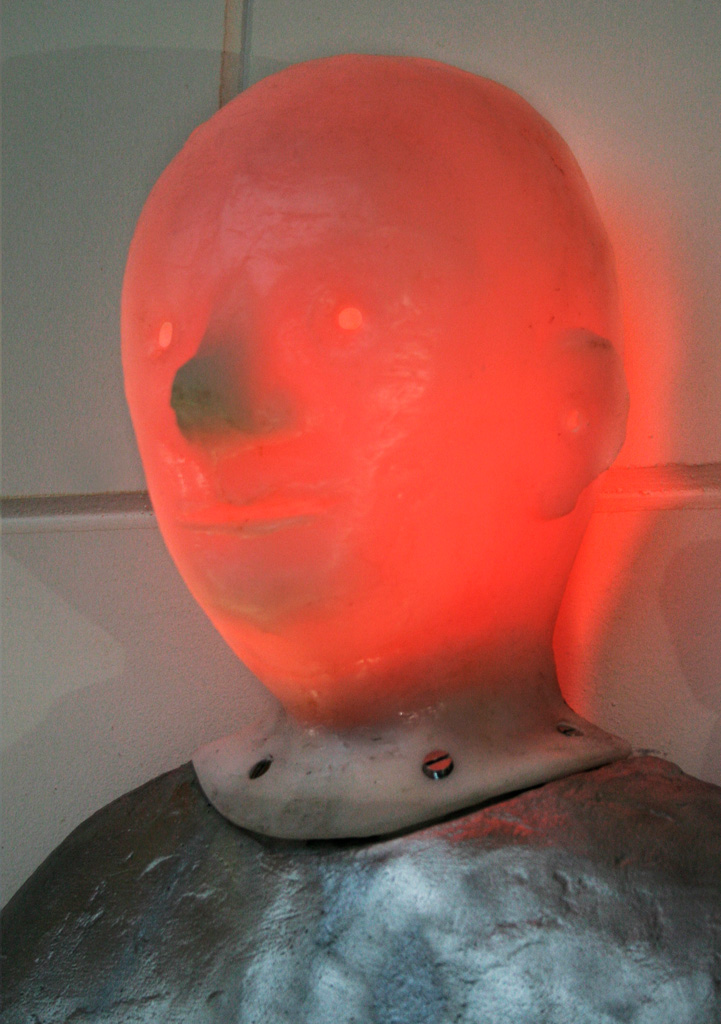

Project voor drie basisscholen, een kinderdagverblijf en een dagcentrum voor verstandelijk gehandicapten in Voorhout die samen in één gebouw gehuisvest zijn (cluster Hoogh-Teylingen). De tijdelijke montage van de vijf delen tot het grote beeld was het centrale onderwerp van een vijfvoudige foto-sessie waar alle gebruikers van het cluster aan deelnamen. Het grote beeld heeft maar één dag bestaan. De onderdelen van de “Gigant van Voorhout” zijn daarna in en rond het gebouw geplaatst.













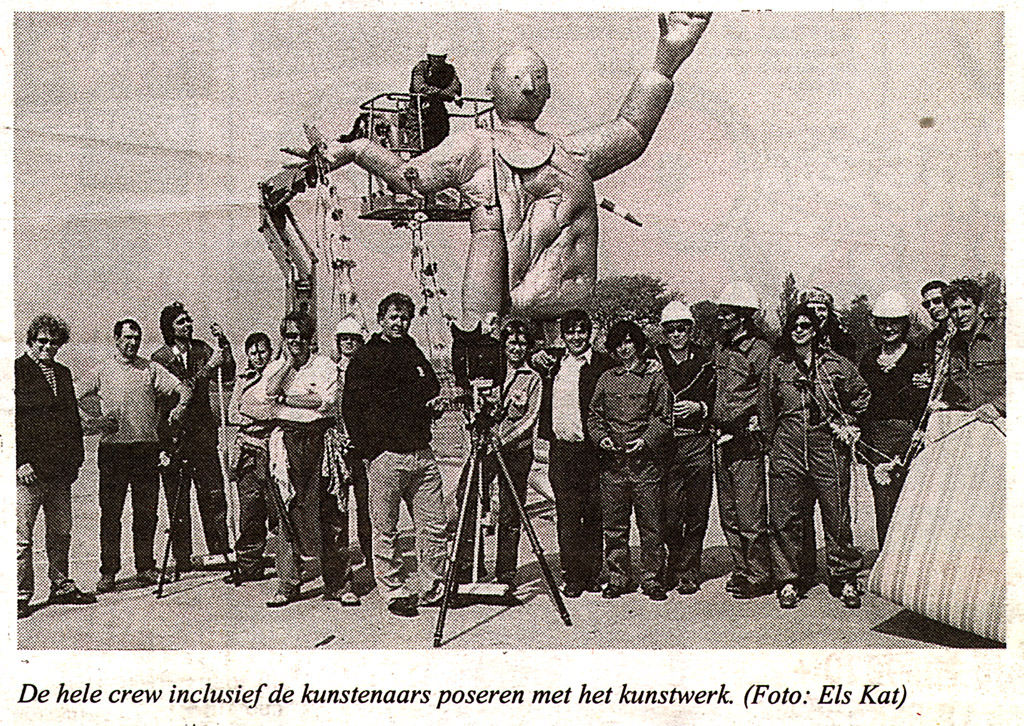

Project voor het Revalidatiecentrum Breda (8 juli, 2000)
tekst: Jorinde Seijdel Op een wat grijze dag in de zomer van het jaar 2000 verzamelden zich ongeveer 50 mensen, volwassenen en kinderen, op een afgelegen weiland bij Breda. Zij waren uitgenodigd door Sylvie Zijlmans & Hewald Jongenelis om aldaar te figureren in een fotosessie voor Revalidatiecentrum Breda. Ze kregen daarbij een maaltijd in de open lucht aangeboden, die ter plekke gemaakt zou worden. Er werd ze, kortom, ook een aangename dag buiten in het vooruitzicht gesteld. Lang niet iedereen uit het gezelschap kende elkaar en lang niet iedereen wist nu precies waarvoor hij kwam. Ook ik was erbij.
Sylvie Zijlmans / ‘Swines and Sheep’ / mixed media / 1999
With ‘Swines and sheep’ Sylvie Zijlmans makes us believe that two large white lamps are eyes that peer around while at the same time she destroys this illusion by periodically switching on the two lamps. By bringing light in the darkness the lamps enable us to see but they also make us visible. The white bulbs are either eyes unable to see anything because of the darkness or they are lamps that bring light, but then there are no eyes to benefit from the light and the visibility that comes with it.
When the bulbs appear to be peering eyes they are irresistible when they suddenly switch on they are annoying (and irresistible to moths). The eyes also see something else: now and then you see images of someone chasing animals. It’s the artist herself trying to catch some sheep.
Sylvie zijlmans: “The projection of two eyes on two lamps originated from a plan where I wanted to project a pig in trouble, but the space was too light so I decided to put even more light on, now and then, and in the end, to project directly into the light as the ultimate consequence of using the coincidence and incorporating the stubbornness of the outside world. Depending on where you stand, the eyes look at you, and try to involve you into their awkward situation.”
Sylvie Zijlmans laat ons met ‘Swines and sheep’ geloven dat de twee grote witte gloeilampen ogen zijn die spiedend in het rond kijken en verstoort die illusie keer op keer door de gloeilampen aan te laten gaan. De lampen brengen licht in de duisternis en maken de wereld zichtbaar, maar tegelijkertijd wordt je ook door de lampen bekeken. De spiedende ogen zijn onweerstaanbaar om naar te kijken, het licht dat ze zo nu en dan verspreiden is elke keer een onaangename verassing. De ogen zien ook nog iets anders: zo nu en dan zijn er beelden van iemand die enige dieren achterna zit. Het is Sylvie Zijlmans zelf die probeert een paar schapen te pakken te krijgen.
Sylvie Zijlmans & Hewald Jongenelis / ‘Gardenuit’ / 1997 / brons / 400 cm hoog
Voor het Meidoornplein in de wijk Tuinzigt in Breda maakten we een flink beeld. Het moest een groot beeld worden, een beeld dat je zag staan, ook als je over de Meidoornlaan door Tuinzigt rijdt, een beeld dat zich in het geheugen nestelt, een beeld dat het plein een voor- en een achterkant geeft , een karakteristiek Tuinzigt beeld.
Het werd een man op een paal, zo’n vier meter hoog en gegoten in brons, en we noemden hem “Gardenuit”. De afgeronde top van de paal raakt het ronde hoofd van de man: hij staat op zijn kop en op de paal staat van boven naar beneden in hoofdletters zijn naam. Er is nóg een paal, daar staat geen man op, en ook geen naam maar horizontale streepjes, als op een meetlat.
Van enige afstand lijkt de omgekeerde man een op een narcis, hij heeft zijn armen en benen gespreid, hij doet een beetje een bloeiende bloem na. Zijn naam is een éénwoordig gedicht met internationale invloeden: letterlijk vertaald vanuit het Frans is hij de nachtwacht, garde de nuit. Dat ‘nuit’ is de tuin van Tuinzigt, en dat garden spreekt voor zich. Maar wat ons betreft is het “De Gardenuit” (met een zachte g) en een gardenuit, dat is een man die ondersteboven het plein als het ware op zijn hoofd draagt. HJ/SZ 1997
Bijdragen aan het Verenigd Europa – Hortus Botanicus, Utrecht 1993